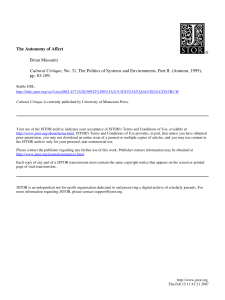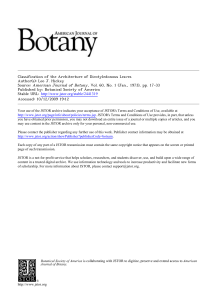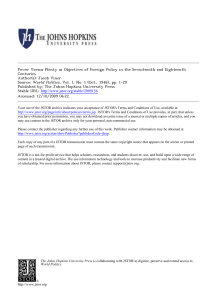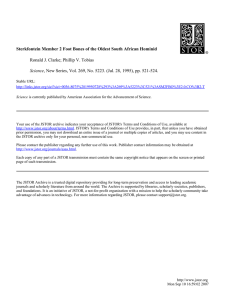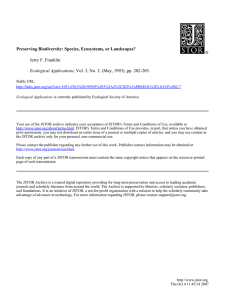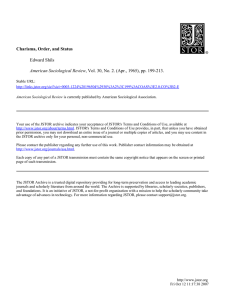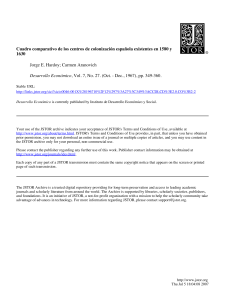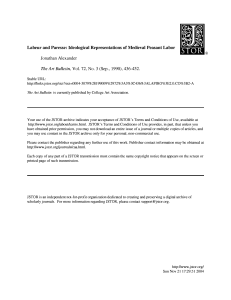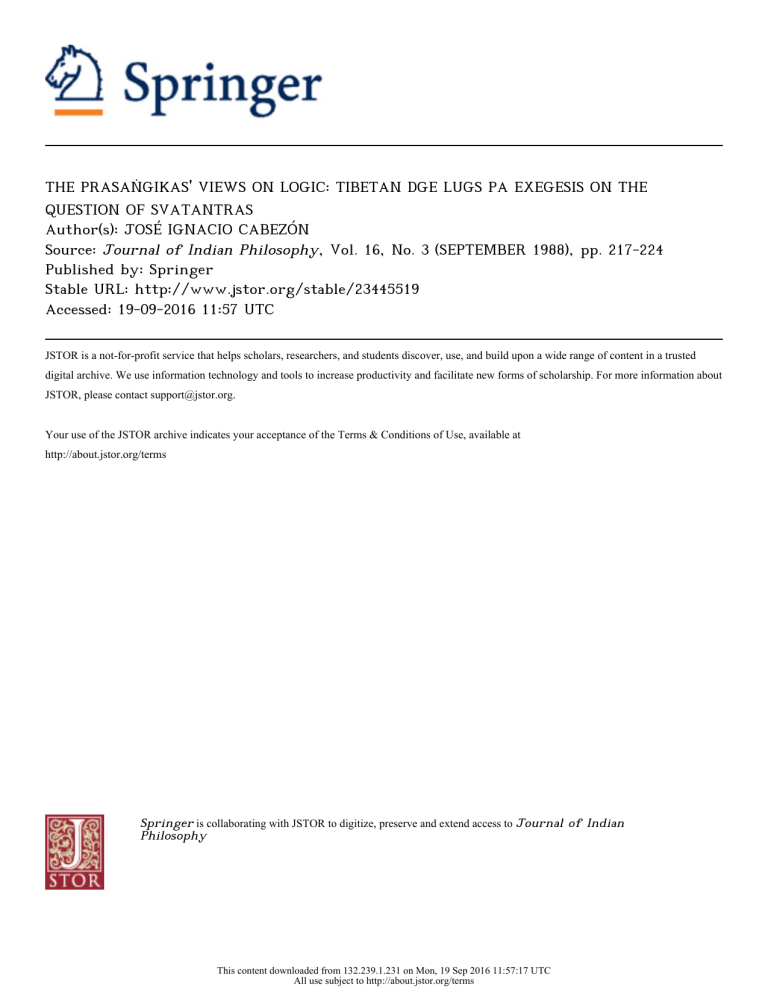
THE PRASAṄGIKAS' VIEWS ON LOGIC: TIBETAN DGE LUGS PA EXEGESIS ON THE QUESTION OF SVATANTRAS Author(s): JOSÉ IGNACIO CABEZÓN Source: Journal of Indian Philosophy, Vol. 16, No. 3 (SEPTEMBER 1988), pp. 217-224 Published by: Springer Stable URL: http://www.jstor.org/stable/23445519 Accessed: 19-09-2016 11:57 UTC JSTOR is a not-for-profit service that helps scholars, researchers, and students discover, use, and build upon a wide range of content in a trusted digital archive. We use information technology and tools to increase productivity and facilitate new forms of scholarship. For more information about JSTOR, please contact [email protected]. Your use of the JSTOR archive indicates your acceptance of the Terms & Conditions of Use, available at http://about.jstor.org/terms Springer is collaborating with JSTOR to digitize, preserve and extend access to Journal of Indian Philosophy This content downloaded from 132.239.1.231 on Mon, 19 Sep 2016 11:57:17 UTC All use subject to http://about.jstor.org/terms JOSÉ IGNACIO CABEZÓN THE PRASAÑGIKAS' VIEWS ON LOGIC: TIBETAN DGE LUGS PA EXEGESIS ON THE QUESTION OF SVATANTRAS 1 One of the most important and most complex topics in the Mâdhya curriculum of the great monastic universities of Tibet dealt with the Prasañgika critique of the svatantra form of reasoning, a type of syllogism which the Prasañgika school considered to be incompatible with the tenets of the Mâdhyamika but which was adhered to by another branch of that same school that eventually came to be calle by that very name, the Svatantrikas. Following the Indian exegesis based on Mùlamadhyamakakârikâs (III, 2),2 the Tibetan analysis focuses the discussion on the nature of the subjects of syllogisms an of the pramànas, the valid forms of knowledge, that perceived them Specifically it had to do with whether the subjects of the syllogisms used by Mâdhyamika appeared in the same way to the Mâdhyamika proponents of the syllogisms as they did to those realists to whom t syllogisms were directed (chos can mthun snang). The remarks that follow are based on the Tibetan dGe lugs pa exegesis on this subjec in many ways the most extensive and detailed treatment of these questions in the corpus of Buddhist literature. We will come back to the specific question of the svatantra presently but first it is worth mentioning that the issue has tremendou implications to a consideration of the Mâdhyamika's views on onto ogy, epistemology and logic. Before proceeding to our main subject, therefore, it is appropriate to turn our attention to the context in which this discussion takes place. In the sTong thun chen mo of mKhas grub dGe legs dpal bzang we find that the subject is intro duced by first considering whether or not the Prasahgikas have any philosophical positions of their own. mKhas grub rje presents the position of an opponent as follows: The Prasañgika Mâdhyamika have no position of their own, no beliefs and nothing all that they accept. Were they to have such beliefs then they would also have to accept such things as the syllogisms (gtan tshigs) which prove the beliefs of their ow system, logical examples and so forth. Were that so, they would essentially becom Svatantrikas.-1 Journal of Indian Philosophy 16 (1988) 217—224. . © 1988 by Kluwer Academic Publishers. This content downloaded from 132.239.1.231 on Mon, 19 Sep 2016 11:57:17 UTC All use subject to http://about.jstor.org/terms 218 JOSÉ IGNACIO CABEZÓN The opponent here is claiming that the Prasañgikas hold no philo sophical positions4 and that if they did they would essentially become Svatantrikas because they would have to rely on the use of syllogistic reasoning to establish these positions, the implication being that in the Màdhyamika school only Svatantrikas use syllogisms.5 The opponent here is operating under the faulty assumption that all syllogisms are svatantras. He then reasons as follows: if all syllogisms are svatantras and Prasañgikas reject the latter, they must also reject the former, in other words they must also reject syllogistic reasoning and logic in general. Syllogisms are the instruments that prove or establish the tenets of any system. If Prasañgikas repudiate syllogistic reasoning they could have no beliefs of their own since they could have no tools with which to establish these beliefs. Hence, concludes the opponent, the Prasañgikas have no system of tenets, no beliefs. The opponent further claims that whatever logical constructs a Prasañgika may employ and whatever views they may seem to set forth: ... are carried out for the sake of confronting others, without it being a reflection of the Prasañgika's own system.6 Given the dGe lugs pa penchant for logical methodology, an out come of the fact that much of their work is directed at creating a synthesis of the traditions of the Màdhyamikas and Prasañgikas, it is scarcely surprising that mKhas grub rje finds this viewpoint anathema to his enterprise. What is most interesting, however, is that he con siders the source of the error to lie in erroneous ontological presup positions, in the fact that the opponent advocates the infamous yod min med min gyi Ita ba, an interpretation of the Màdhyamika in which emptiness is considered a middle ground between existence and non-existence. Of course for mKhas grub rje, who is a staunch advocate of the principle of the excluded middle, there is no middle ground between existence and non-existence. If the existence of something is repudiated it is a tacit affirmation of its non-existence and vice versa. For mKhas grub rje the idea that things are neither existent nor non-existent is at best nonsensical and at worst nihilistic. He says in this regard: Those who make such claims (that the Prasañgikas repudiate reasoning and have no This content downloaded from 132.239.1.231 on Mon, 19 Sep 2016 11:57:17 UTC All use subject to http://about.jstor.org/terms THE PRASAÑGIKAS' VIEWS ON LOGIC 219 tenets of their own) have, as I have mentioned before, misapprehended the extent of what is to be refuted. Hence they think that the reasoning of the Prasañgika Mádhyamikas is refuting all phenomena. Once they have refuted everything, seeing that all of their arguments can be used to refute what they themselves believe, they discard the notion that all of those absurdities urged on others are applicable to themselves. But when such absurdities are urged on them, being totally unaware of how to avert such arguments (when turned against them), their one last hope is to say "We accept nothing."7 What mKhas grub rje is saying is that the logical skepticism of this opponent (his view that the Prasañgikas accept nothing and repudiate syllogistic logic) is a corrolary of his ontological nihilism (his view that the Prasahgika critique is a critique of the existence of all phenomena). Put in another way, mKhas grub rje is saying that this brand of logical skepticism is the last refuge of the ontological nihilist, who, realizing that his own faulty arguments will soon be turned against him, attempts to immunize himself from logical fault by declaring himself to have no position, appending the disclaimer that any logic he has used was employed only in confrontation with his challenger and not because he himself ascribed to the validity of reasoning (syllogistic or otherwise). What I find fascinating about mKhas grub rje's analysis (and I ought to mention that this is a theme that we find repeated throughout the sTong thun then mo) is his connection of ontological, logical, epistemological and soteriological forms of skepticism or nihilism. For mKhas grub rje the yod min med min view, which he characterizes as "refuting all phenomena", i.e., as ontological nihilism, the view that the Prasañgikas repudiate syllogistic reasoning — a form of logical skepticism, the view that they repudiate the notion of pramána — a form of epistemological skepticism, and the view that in meditation the mind is to be emptied of all thought, the infamous Hva shan view and a form of soteriological nihilism,s according to mKhas grub rje, are just different sides of the same coin (or more appropriately the same four-sided pyramid). Each of these positions he sees as not only being tied to each other historically but as being corrollaries of each other in the logical sphere as well. All of this by way of contextualization; let us return to our main topic, the discussion of the svatantra. We saw that mKhas grub rje's first opponent held the position that all syllogisms were svatantric in nature and that since Prasañgikas This content downloaded from 132.239.1.231 on Mon, 19 Sep 2016 11:57:17 UTC All use subject to http://about.jstor.org/terms 220 JOSÉ IGNACIO CABEZÓN repudiate the latter they must also repudiate syllogistic reasoning and logic in general. Another opponent is characterized as follows: Even Prasañgikas accept svatantra syllogistic reasoning (rang rgyud kyi rtags) becaus they accept tri-modal syllogistic reasoning (tshul gsum pa'i rtags) which proves a specific quality (khyad par kyi chos) of a certain subject (chos can) that is established by the pramànas of both the proponent (of the syllogism) and the opponent (to who it is posited).9 This second opponent shares one presupposition with the first, namely that all syllogisms are svatantra forms of syllogisms, but realizing that it would be absurd to deny the Prasañgikas' use of logic, he maintains instead that since Prasañgikas accept syllogistic reasoning they must also accept svatantras. Both views, of course, are, in the opinion of the dGe lugs pa exegetes, faulty, the source of their fault lying in their common presupposition that all syllogisms are svatantric in nature. mKhas grub rje's belief is that Prasañgikas accept tri-modal syllogistic reasoning (tshul gsum pa 'i rtags) but not of the svatantra variety. What then characterizes a syllogism as being a svatantra? mKhas grub ije states: . . . when positing a svatantra position or logical reason it is not enough that both the proponent and the opponent establish, by means of a pramána, the subject of the inquiry (sites 'dod chos can) which is the basis upon which a predicate is posited. Instead, it is absolutely necessary that (the subject) be established compatibly (mthun snang du).10 But what does it mean to be "established compatibly"? To put it simply it means this. Prasañgikas have a different notion of entities than do Realists. When they posit a syllogism to a Realist they under stand that the subject of the syllogism (and indeed all of its parts, including the tri-modal relations) are not subjects that exist inherently. Despite this fact Prasañgikas believe that entities appear to the con sciousness of every sentient being (pramànas or otherwise) to exist as if they were real and independent. Hence they realize that the pramána which perceives the subject of a syllogism is erroneous ('khrul pa). This is of course not the case with the Realists, for whom: ... all pramànas are believed to be valid in regard to subjects that exist by virtue of their own characteristic. In their system all pramànas are forms of consciousness that are non-erroneous in regard to their objects; it is believed that if the subject of a syllogism is established by a pramána, then that very subject must be an object which is found (rnyed don) by the pramána.'1 This content downloaded from 132.239.1.231 on Mon, 19 Sep 2016 11:57:17 UTC All use subject to http://about.jstor.org/terms THE PRASAÑGIKAS' VIEWS ON LOGIC 221 Therefore, according to mKhas grub rje, a svatantra is a syllogism in which the subject is "established compatibly" in the system of both the proponent and opponent where both parties consider it to be the object perceived by a pramâna that is non-erroneous in regard to the ontological status of the object. In other words, it is a syllogism in which both parties consider the subject to be a real independent entity that is verified as such by a non-erroneous pramâna. Since this is inconsistent with the Prasañgika view that (a) no such entity exists and that (b) any consciousness to which an entity appears in this way must be erroneous, svatantra forms of syllogistic reasoning are unacceptable to this school. This does not mean, however, that Prasañgikas repudiate syllogistic reasoning in general. Instead they employ a form of syllogism known as "inference based on what is renowned to another" (gzhan la grags pa'i rjes dpag)'2 which mKhas grub rje defines as: ... a syllogistic reason in which the subject, though not perceived by pramâna in a way that is compatible to both the proponent and opponent, is nonetheless perceived by a pramâna in the system of the proponent and by a pramâna in the system of the opponent and which is posited (by the proponent) while "feigning the acceptance" ( 'khris nas) of what the opponent believes in his/her system as regards the perception of the subject by a pramâna." That is to say that in an "inference based on what is renowned to another" the Prasañgika proponent will feign acceptance of the opponent's notion of the nature of the subject and of the pramâna which perceives it, all the time realizing that his/her own notion is completely different, i.e., incompatible, with the opponent's. But despite the incompatibility of the way in which the subject exists and in the way in which the pramâna which perceives it functions, an "inference based on what is renowned to another" is nonetheless a valid tri-modal syllogism. In this way, mKhas grub rje demonstrates that not ail syllogistic reasoning is svatantric in nature, that there does in fact exist a form of such reasoning that is compatible with Prasañgika Màdhyamika tenets and therefore that the latter do not repudiate logic in general. Whether or not mKhas grub rje's analysis is truly representative of the Indian Màdhyamika tradition to which he claims to be heir is a question that this paper does not seek to answer. What is far more interesting to me is the fact that mKhas grub rje (and his teacher This content downloaded from 132.239.1.231 on Mon, 19 Sep 2016 11:57:17 UTC All use subject to http://about.jstor.org/terms 222 JOSÉ IGNACIO CABEZÓN Tsong kha pa) interpret the repudiation of the svatantra as they do. Throughout, they view their efforts as an attempt to set straight the score concerning the Prasañgika's views on logic, which, as we have seen, is part of a more general campaign, that of upholding the validity of rationality (the possibility of valid knowledge), language (its ability to describe reality) and logical principles (such as that of the excluded middle). Whether or not the dGe lugs pas succeed in their endeavor is also a question that has yet to be answered. That it is a stance to be reckoned with in any treatment of the Mádhyamikas' views on logic is an indisputable fact. NOTES 1 An earlier version of their paper was presented at a panel entitled 'Nà His Successors: Perspectives on "Middleism"' at the 15th annual confer Asia at the University of Wisconsin, Madison. Thanks must go to Profes Jackson of Fairfield University, the discussant, and especially to Profes of the University of Wisconsin, Madison, the organizer of the panel, wh opportunity for a very lively exchange of ideas possible. : Peking edition of the bsTan 'gyur |Tokyo: Tibetan Tripitika Research In 1957| (hereafter cited as P), dBu ma tsa, folio 4a; this is of course comm Buddhapâlita, ibid, folio 197b, by Candrakîrti in his Prasannapadâ, L. Poussin edition |Bibliotheca Buddhica IV], pp. 34 passim. sDe dge edit Faculty of Letters of the University of Tokyo, 1978] dBu ma 'a, folio 1 general discussion of the issue in the Prasannapadà however begins earlie p. 29, Tibetan folio 9a) with a discussion of the compatibility of the sub syllogism based on the renowned example of the "impermanence of soun however another extensive discussion on the meaning of svatantra reaso Prasannapadà in its extensive commentary to the first verse of the Kâr p. 14, Tibetan folio 5b). This is the renowned passage in which Candrakîr Bhávaviveka's attack of Buddhapálita's methodology. It is commented sively in the sTong thun chen mo of mKhas grub rje (see note 3) on p ■' mKhas grub dGe legs dpal bzang, sTong thun chen mo in Mâdhyamik Vol. 1, [New Delhi: Lha mkhar yongs 'dzin, 1972], p. 294 (all page num the Arabic enumeration of the folios of the text). 4 Nor are such opponents a thing of the past. This is, for example, the taken by Mervyn Sprung in his 'Nietzsche and Nágárjuna: The Origins an of Skepticism' | Re relation in Indian Thought, edited by H. Coward and (California: Dharma, 1977): Buddhi, the ratiocinative faculty, is as subject to the kles'as as character (saihskaras) are. The Mâdhyamikas' attack on all theories, all ways of lo things, all perspectives, as the key to removing the klesas, follows from This content downloaded from 132.239.1.231 on Mon, 19 Sep 2016 11:57:17 UTC All use subject to http://about.jstor.org/terms THE PRASAÑGIKAS' VIEWS ON LOGIC And also: . . . Mâdhyamika sets out, as is well known, to undermine not only all philosophies and all ideologies but every last category and concept constituting the everyday world on which the philosophies and ideologies are founded, (p. 165) Nor is Mr. Sprung alone; for a detailed discussion of this view in the Western academic literature see 'Dzong kha pa and Modern Interpreters II: Negating Too Much', Chapter Five of E. S. Napper's Dependent-Arising and Emptiness [University of Virginia: Ph.D. Dissertation, 1985|, pp. 159—193. See also my A Buddhist Philos ophy of Language and Its Culmination in Tibetan Mâdhyamika Thought [University of Wisconsin: Ph.D. Dissertation. I987|. 5 This also seems to be the view of D. S. Ruegg in his 'The Uses of the Four Posi tions of the Catuskoti and the Problem of the Description of Reality in Mahâyâna Buddhism' \Journal of Indian Philosophy 5 (1977), pp. 8—9| and also throughout his 'On Thesis and Assertion in the Màdhyamika/dBu ma' [in E. Steinkellner and H. Tauscher, editors, Contributions on Tibetan and Buddhist Philosophy (Vienna: Institute for Tibetan and Buddhist Studies, 1983)] (see especially pp. 224—225 and 234-236). 6 Op. cit., p. 295. 7 Ibid., p. 296. K To what extent these views were, individually or collectively, held by historical personages is an extremely difficult question to answer and one which is, in any case, beyond the scope of this paper. The reader is referred to D. S. Ruegg's The Literature of the Mâdhyamika School of Philosophy in India [Wiesbaden: Otto Harrasowitz, 19811 and to the 'Introduction' of R. A. F. Thurman's Essence of True Eloquence [Princeton, Princeton University Press, 1984], See also Paul Williams' 'rMa bya pa byang chub brtson'grus on Madhyamaka Method' IJournal of Indian Philosophy 13 (1985), pp. 205-225], 9 Op. cit., p. 313. I,1 Ibid., pp. 316—317. He then goes on to state that not only must the subject of the syllogism be established in this way but that indeed so must all of the other parts of the syllogism including the tri-modal criteria. 11 Ibid., pp. 317—318. 12 Paraprasiddha or I'arasiddlui (anumâna) — see, for example, the I'rasannapadá of Candrakirti edited by L. de la Vallée Poussin [Bibliotheca Buddhica IV], pp. 34—35 and 272. 13 Op. cit., p. 318. BIBLIOGRAPHY Buddhapülita, Buddhapálitavrtti, Tibetan translation in bsTan 'gyur Tokyo: Tibetan Tripitika Research Institute, Vol. tsa, 1957. Cabezón, J. I. (1987). A Buddhist Philosophy of Language and Its C Tibetan Màdhyamika Thought, Ph.D. Dissertation. Madison: Univer Wisconsin. This content downloaded from 132.239.1.231 on Mon, 19 Sep 2016 11:57:17 UTC All use subject to http://about.jstor.org/terms JOSÉ IGNACIO CABEZÓN Candrakïrti, Prasannapadâ, edited by Louis de la Vallée Poussin. Bibliotheca Buddhica, Vol. IV. St. Petersbourg: Academie Imperiale des Sciences, 1913. Candrakïrti, Prasannapadâ, Tibetan translation in bsTan 'gyur (sDe dge edition). Tokyo: Faculty of Letters of the University of Tokyo, 1978. mKhas grub dGe legs dpal bzang, sTong thun chen mo, edited by Lha mkhar yongs 'dzin. Delhi: Mádhyamika Text Series Vol. 1, 1972. Nâgârjuna, Mülamadhyamakakáriká, Tibetan translation in bsTan 'gyur (Peking edition). Tokyo: Tibetan Tripitika Research Institute, Vol. tsa, 1957. Napper, E. S. (1985). Dependent-Arising and Emptiness, Ph.D. Dissertation. Charlottesville: University of Virginia. Ruegg, D. S. (1977). 'The Uses of the Four Positions of the Catuhskoti and the Problem of the Description of Reality in Mahâyâna Buddhism', Journal of Indian Philosophy 5, 1—52. Ruegg, D. S. (1981). The Literature of the Mádhyamika School of Philosophy in India. Wiesbaden: Otto Harrasowitz. Ruegg, D. S. (1983). 'On Thesis and Assertion in the Madhyamaka/dBu ma' in Contributions on Tibetan and Buddhist Philosophy, edited by E. Steinkellner and H. Tauscher. Vienna: Institute for Tibetan and Buddhist Studies. Sprung, M. (1977). 'Nietzsche and Nâgârjuna: The Origins and Issues of Skepticism' in Revelation in Indian Thought, edited by H. Coward and K. Sivaraman. Berkeley: Dharma Publications. Thurman, R. A. F. (1985). Essence of True Eloquence. Princeton: Princeton University Press. Williams, P. (1985). 'rMa bya pa byang chub brtson 'grus on Madhyamaka Method', Journal of Indian Philosophy 13, 205—225. Trinity College Department of Religion Hartford, Connecticut, U.S.A. This content downloaded from 132.239.1.231 on Mon, 19 Sep 2016 11:57:17 UTC All use subject to http://about.jstor.org/terms
